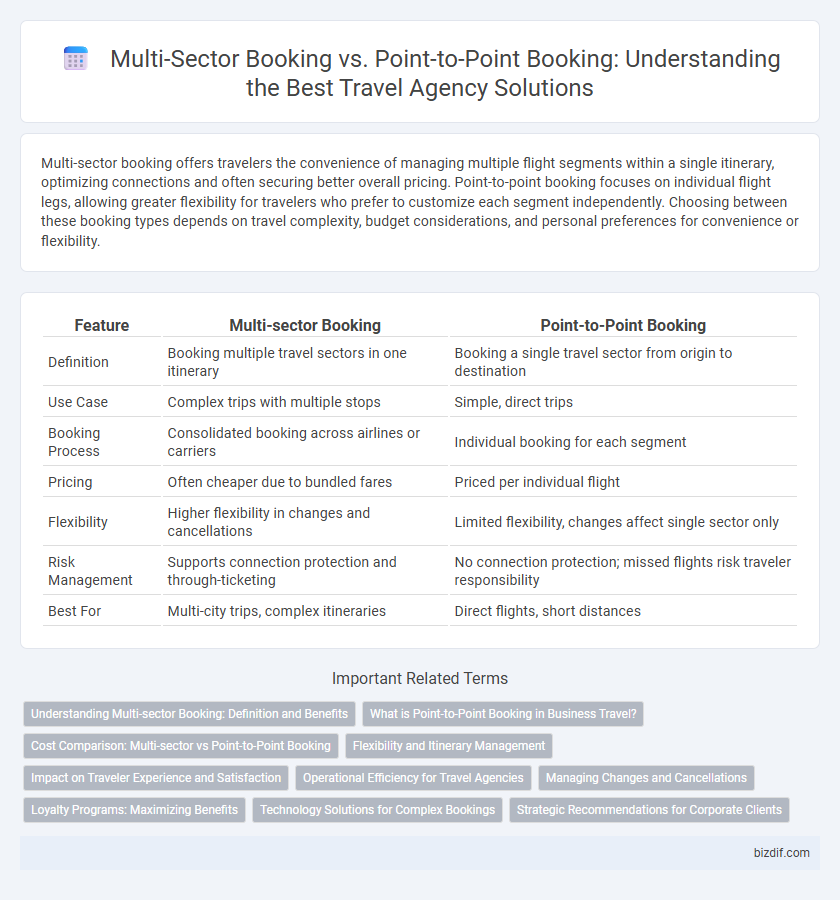Multi-sector booking offers travelers the convenience of managing multiple flight segments within a single itinerary, optimizing connections and often securing better overall pricing. Point-to-point booking focuses on individual flight legs, allowing greater flexibility for travelers who prefer to customize each segment independently. Choosing between these booking types depends on travel complexity, budget considerations, and personal preferences for convenience or flexibility.
Table of Comparison
| Feature | Multi-sector Booking | Point-to-Point Booking |
|---|---|---|
| Definition | Booking multiple travel sectors in one itinerary | Booking a single travel sector from origin to destination |
| Use Case | Complex trips with multiple stops | Simple, direct trips |
| Booking Process | Consolidated booking across airlines or carriers | Individual booking for each segment |
| Pricing | Often cheaper due to bundled fares | Priced per individual flight |
| Flexibility | Higher flexibility in changes and cancellations | Limited flexibility, changes affect single sector only |
| Risk Management | Supports connection protection and through-ticketing | No connection protection; missed flights risk traveler responsibility |
| Best For | Multi-city trips, complex itineraries | Direct flights, short distances |
Understanding Multi-sector Booking: Definition and Benefits
Multi-sector booking enables travelers to reserve multiple flight segments within a single itinerary, streamlining travel plans across various destinations and airlines. This method offers cost savings, flexible scheduling, and enhanced convenience by consolidating all bookings under one transaction. Travel agencies benefit from multi-sector bookings through improved itinerary management and increased customer satisfaction by providing seamless travel solutions.
What is Point-to-Point Booking in Business Travel?
Point-to-point booking in business travel refers to reserving transportation or accommodations for a single, direct route between two specific locations without intermediate stops. This type of booking streamlines travel arrangements by focusing solely on the main journey segment, making it ideal for straightforward trips and time-sensitive itineraries. Businesses often choose point-to-point bookings to reduce complexity and optimize travel costs for employees traveling between primary destinations.
Cost Comparison: Multi-sector vs Point-to-Point Booking
Multi-sector booking often reduces overall travel expenses by combining multiple flight segments into a single itinerary, leveraging airline partnerships and fare bundling to secure lower prices than separate point-to-point bookings. Point-to-point booking can lead to higher costs due to purchasing individual tickets for each leg, losing out on potential discounts and increasing baggage fees or change penalties. Travel agencies analyze fare rules and carrier alliances to optimize cost-efficiency, favoring multi-sector itineraries for cost-sensitive travelers.
Flexibility and Itinerary Management
Multi-sector booking offers enhanced flexibility by allowing travelers to customize complex itineraries with multiple stops, optimizing connections and layover times to suit personal preferences and schedules. This method simplifies itinerary management by consolidating all segments under a single reservation, enabling easier modifications and centralized customer support. In contrast, point-to-point booking restricts travel to direct routes between two destinations, limiting adaptability and requiring separate reservations for each leg, which complicates overall trip coordination.
Impact on Traveler Experience and Satisfaction
Multi-sector booking enhances traveler experience by offering seamless coordination across multiple destinations, reducing the risk of missed connections and providing a unified itinerary. This comprehensive approach improves satisfaction through consistent service quality and streamlined customer support, minimizing travel stress. In contrast, point-to-point booking can lead to fragmentation, increasing the likelihood of delays and complications that negatively affect overall travel enjoyment.
Operational Efficiency for Travel Agencies
Multi-sector booking streamlines operational efficiency for travel agencies by consolidating multiple flight segments into a single transaction, reducing manual entry and minimizing errors. This approach enables centralized management of itinerary changes and payments, leading to faster processing times and improved customer service. In contrast, point-to-point booking requires separate handling for each segment, increasing workload and the risk of inconsistencies in travel arrangements.
Managing Changes and Cancellations
Multi-sector booking offers increased flexibility in managing changes and cancellations by consolidating multiple travel segments into a single itinerary, allowing travelers to modify or cancel parts of their trip without affecting the entire reservation. Point-to-point booking requires separate handling for each leg, often resulting in higher fees and more complex coordination during adjustments. Travel agencies benefit from multi-sector booking by streamlining customer support and reducing penalty costs associated with fragmented bookings.
Loyalty Programs: Maximizing Benefits
Multi-sector booking enhances loyalty program benefits by allowing travelers to accumulate more points across various airlines and service providers, maximizing rewards versatility. Compared to point-to-point booking, it offers greater flexibility in choosing flights, accommodations, and car rentals within a single itinerary, increasing cumulative loyalty earnings. Frequent travelers leveraging multi-sector bookings unlock exclusive upgrades, priority boarding, and bonus miles, optimizing overall loyalty program value.
Technology Solutions for Complex Bookings
Multi-sector booking leverages advanced technology solutions like AI-powered platforms and integrated Global Distribution Systems (GDS) to streamline complex itineraries involving multiple carriers and destinations. These systems enable real-time inventory management, dynamic pricing, and seamless coordination across airlines, hotels, and ground transport. Point-to-point booking relies on simpler technology with direct connections between origin and destination, lacking the flexibility and comprehensive integration needed for multi-leg journeys.
Strategic Recommendations for Corporate Clients
Multi-sector booking offers corporate clients enhanced itinerary flexibility by combining multiple flights, accommodations, and transport sectors into a single transaction, optimizing travel time and costs. Leveraging advanced booking platforms that support multi-sector arrangements allows travel agencies to tailor intricate travel plans aligning with corporate schedules and budget constraints. Corporate clients benefit strategically from negotiated bulk rates and improved travel policy compliance through multi-sector bookings, making it a preferable approach over traditional point-to-point methods.
Multi-sector Booking vs Point-to-Point Booking Infographic

 bizdif.com
bizdif.com